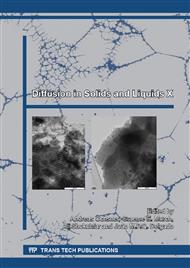[1]
С.А. Wert: Hydrogen in metals. Topics in applied physics. 29 (1978), p.305–330.
Google Scholar
[2]
Y.S. Bordulev, R.S. Laptev, V.N. Kudiyarov, A.M. Lider: Advanced Materials Research. Vol. 880, 93 (2014).
Google Scholar
[3]
R.S. Laptev, Y.S. Bordulev, V.N. Kudiyarov, A.M. Lider, G.V. Garanin: Advanced Materials Research, Vol. 880, 134 (2014).
Google Scholar
[4]
Y. Fukai, N. Okuma: Phys. Rev. Lett. 73 (1994), p.1640–1643.
Google Scholar
[5]
Y. Shirai, H. Araki, T. Mori, W. Nakamura, K. Sakaki: J. Alloys Compd. 330 (2002), p.125–131.
Google Scholar
[6]
J. Cizek, I. Prochazka, S. Danis, M. Cieslar, G. Brauer, W. Anwand, R. Kirchheim, A. Pundt: Journal of Alloys and Compounds. 446-447 (2007), pp.479-483.
DOI: 10.1016/j.jallcom.2006.11.105
Google Scholar
[7]
J. Cizek, I. Prochazka, F. Becvar, R. Kuzel, M. Cieslar, G. Brauer, W. Anwand, R. Kirchheim, A. Pundt: Physical Review. B 69 224106 (2004).
Google Scholar
[8]
R. Krause-Rehberg, H.S. Leipner. Positron Annihilation in Semiconductors: Defect Studies, third ed., Berlin Heidelberg, New York (2003).
Google Scholar
[9]
V.I. Grafutin, E.P. Prokop'ev: Physics-Uspekhi. 172, 1 (2002), p.67–83.
Google Scholar
[10]
A. Dupasquier, A.P. Mills: Proceedings International School of Physics Enrico Fermi, Course CXXV. (1995).
Google Scholar
[11]
G.J.C. Carpenter, H.T. Easterday, B.T.A. McKee: Journal of Nuclear Materials. 116 (1983), pp.277-286.
Google Scholar
[12]
Y. Chen, X. Wan, F. Li et al.: Materials Science and Engineering: A. 466 (2007), p.156–159.
Google Scholar
[13]
V.N. Kudiiarov, L.V. Gulidova, N.S. Pushilina, A.M. Lider: Advanced Materials Research. 740 (2013), pp.690-693.
DOI: 10.4028/www.scientific.net/amr.740.690
Google Scholar
[14]
L.V. Gulidova, V.N. Kudiiarov, N.A. Dubrova, A.M. Lider: Alternativnaya energetika i ekologiya. 03. 2 (2013), p.32–35.
Google Scholar
[15]
D. Giebel, J. Kansy: Materials Science Forum. 666 (2010), pp.138-141.
Google Scholar
[16]
J. Cizek, M. Vlcek, I. Prochazka: Nuclear Instruments and Methods in Physics Research Section A. 623 (2010), pp.982-994.
Google Scholar
[17]
Information on http: /www. ifj. edu. pl/~mdryzek/page_h1. html.
Google Scholar
[18]
J. M. Campillo Robles, E. Ogando, F. Plazaola: J. Phys.: Condens. Matter 19 (2007) 176222.
Google Scholar
[19]
L.V. Spivak. Hydrogen in metals. Perm (2011), p.149.
Google Scholar
[20]
J. Cizek, O. Melikhova, Z. Barnovska, R. K. Islamgaliev: Journal of Physics: Conference Series 443 (2013) 012008.
Google Scholar
[21]
H. E Hansen, R M Nieminen and M J Puska: J. Phys. F: Met. Phys. 14 (1984), p.1299.
Google Scholar
[22]
J. Cizek. Investigation of Crystal Lattice Defects in Deformation and Irradiation Damaged Solids by Means of Positron Annihilation. Prague (2001), p.98.
Google Scholar


